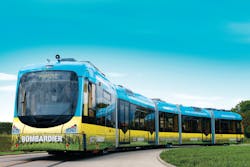As rail transit continues its revival in cities across North America, regulators have been right on its heels demanding systems get greener while customers are asking manufacturers and designers to build them better, more efficient systems to provide the best return to riders.
While there's lots of challenges to meet these demands, train technology has kept pace and now systems are finding lots of options at their disposal when building their system or replacing legacy equipment.
Meeting new regulations and standards is a common concept in transit, but when the concept of Tier 4 emissions requirements came along, it presented a new big challenge for diesel engine builders who had to find a way to meet stringent new emissions requirements while not losing power.
The deadline is looming for compliance with the law, but unlike other new regulations engulfing the rail industry, there are signs of hope in meeting Tier 4 and in a rather painless fashion.
“I think we’re well ahead of the curve in meeting Tier 4,” said Glen Rees, business manager of rail for the Americas for Cummins Inc.
Rees said two of the companies train engines have been been certified in meeting the requirement and Amtrak is taking delivery of one of the engines. Cummins is also supplying the units for the new Nippon Sharyo cars being delivered to Metrolinx Go Transit trains in the metro Toronto area, which will be placed into service there.
With SCR technology the company has been using for years, Rees, said Cummins was able to meet Tier 4 with no need to make big changes to the design of its engines or without losing power.
Many regulations can cause difficulties for manufacturers facing multiple different challenges for the markets it serves, but Rees said meeting Teir 4 allowed for a standardization of its product lines.
With stricter emissions standards set to come to locomotives, some designers are looking to natural gas a viable option to meet these news standards, but Ryan Erickson, senior project director for Gladstein, Neandross & Associates, said safety standards basically don’t exist right now so until the Federal Railroad Administration put them in place, it’s not going to move into place. The use of natural gas in rail is starting in the freight area given the extra level of safety issues to address with passenger rail.
“I do think you’ll find in 2-5 years that there will be some regulations in place and people will seriously start considering natural gas in passenger rail,” he said.
More than just power plant needs
Getting to the next level of rail propulsion isn’t just about what’s inside the locomotive, but the investment leaders and planners are willing to make to tracks and the creation of new rail corridors.
Antonio Perez, president and CEO of Talgo USA, said taking on an initiative like high-speed rail in the U.S., is going to need some major political will and funding commitments from federal and state governments if propulsion for these lines is going to take off.
Perez says he sees will building on improving tracks for projects like high-speed rail by building successful regional projects first, then incrementally upgrading speeds as the system continues to gain more success.
Perez said it can be difficult as a manufacturer to get behind a project if a proposal is sent out by a state or transit agency even though there isn’t funding in place already.
High-speed rail can grow in the country, but Perez is much less optimistic about Maglev or ultra-Maglev trains coming to the continent en mass like other parts of the world.
“I don’t see that,” he said. “It’s very expensive, maybe 10 times more expensive than high-speed rail.”
Taking rail propulsion to the next level is also going to take will to change rules and regulations governing manufacturers so it can provide an environment where they’re pushed to become more innovative in their products. Foreign companies have designed equipment to meet the ongoing needs of next-generation rail propulsion, Perez said, but because it doesn’t meet Buy American requirements, it can’t be used.
“You know, we need to provide equipment that’s proven and within the U.S. we have to comply with Buy U.S.,” Perez said. “But sometimes you can’t have something that’s a proven technology within the U.S. when there’s no history of that equipment being built in the U.S. and that’s a big challenge.”
Going off wire
Across the globe more transit providers with streetcar circulator or tram services are looking to upgrade their systems and take it to a new level of operation. And in some areas where there’s a lot of historic buildings, there’s little political will to sink supports into the structures to install catenary wires when a new line goes up.
The big solution for many of these agencies is to take their systems off wire and install catenaryless systems where batteries or quick chargers are used to keep electric railcars moving. And issues such as massive batteries taking up space and weighing down the cars has become a thing of the past.
“We’re past that, there’s no problem,” said Jeremie Desjardins, director of Primove for Bombardier Transportation. “You don’t need big batteries and we at Bombardier our solution in no way impacts the car or the number of passengers when there’s no catenary.”
Desjardins said catenary-free tramways are being built or considered in Europe and China for new systems going into cities there. The system brings additional benefits to cold climate cities where wires can ice over in the winter and less maintenance will go into the system overall, which means the total lifetime costs can be much less than a traditional catenary systems.
Some systems use ultracapacitors or partial catenary systems to run a larger catenary-free train system, but fast charging systems are also being used to keep trams moving.
Primove has a wireless charging system running below the trains, which allows for a system to keep charged as it moves along the line
The system is even being used in a fast charging environment for electric buses. Braunschweiger Verkehrs-AG in Braunschweig, Germany uses the fast charging system on its first electric bus, which went into service earlier this year. The inductive fast charging system puts out 200 KW of power when the bus comes to a stop, giving it the power to make it to the next stop where it recharges again.
The technology is also transferring to buses in Berlin, Mannheim, Germany and Bruges, Belgium.
In Dallas, the Dallas Area Rapid Transit is currently building a streetcar line which will run without catenary wire on part of the route. The cars, which are being manufactured by Brookville, will be equipped with lithium ion batteries in order to allow the railcars to do so.
Adam Mahoney, marketing specialist with Brookville, said there are many solutions available for a catenary-free streetcar system, but the Dallas cars use the lithium ion batteries so they have a longer run as opposed to using a super capacitor, which tend to be used for cars needing a shorter burst sans wire, such as clearing a highway overpass.
“We’ve developed multiple solutions, so it really depends on existing needs,” he said. “It’s really about matching the right solution with the needs of a city.
Mahoney said there’s lot of interest from cities about using catenaryless streetcar systems because of they provide an option to put streetcars in areas where they weren’t feasible before.
Off wire technology is relatively new, especially domestically here in the U.S., so there’s growing interest in it,” he said. “There’s more interest in the different systems available and how do they work and discovering from a city side what solution fits their needs.

Joe Petrie | Associate Editor
I came to Mass Transit in 2013 after spending seven years on the daily newsbeat in southeastern Wisconsin.
Based in Milwaukee, I worked as a daily newspaper reporter with the Waukesha Freeman from 2006-2011, where I covered education, county and state government. I went on to cover courts for Patch.com, where I was the main courts reporter in the Metro Milwaukee cluster of websites.
I’ve won multiple awards during the course of my career and have covered some of the biggest political events in the past decade and have appeared on national programs.
Having covered local government and social issues, I discovered the importance of transit and the impact it can have on communities when implemented, supported and funded.


